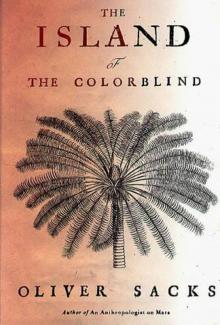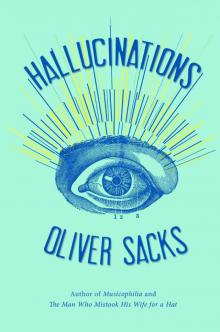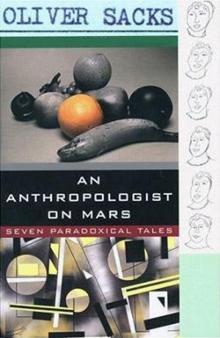- Home
- Oliver Sacks
Oaxaca Journal
Oaxaca Journal Read online
Acclaim for Oliver Sacks’s
OAXACA JOURNAL
“Light and fast-moving.… Among the botanical and anthropological observations, one catches glimpses of Sacks’s inner life: his preoccupation with dualities, his nearly Victorian sense of modesty, his fascination with the world around him.”
—The New Yorker
“Like all the best journals, it has a rich immediacy, a sense that we share the moment of the author’s perceptions. Since Sacks is such a lovely writer, and he and his fellow travelers such fonts of knowledge about everything from Mexican history to Mayan culture to chocolate making to the workings of fern evolution, the book is a rare treat.… It makes you want to strap on your field glasses and catch the first flight south.”
—The Globe and Mail
“Relaxed yet observant.… [Sacks’s] thoughtful, sometimes wistful ruminations, no matter how expansive they may grow, are always rooted in the concrete details he has observed.… Those who read Oaxaca Journal will appreciate Sacks’s own diligence as an observer and his skill in translating the wonders of the material world into words.”
—Los Angeles Times
“Oaxaca Journal whipped up my appetite for a visit to Mexico, as the best travel writing does.”
—The Providence Journal
“The combination of his insatiable curiosity and rigorous scientific observation makes him an excellent travelling companion.… Mexico past and present emerges from these bursts of association and digression.… With so much of the world made superficially familiar by tourism, Oliver Sacks’s dogged pursuit of the exotic is especially welcome. He has, moreover, succeeded in striking that elusive balance of input between traveler and culture that makes for good travel writing.”
—Times Literary Supplement (London)
“Bittersweet and profound.… Truly a lovely book.”
—Chicago Tribune
OLIVER SACKS
OAXACA JOURNAL
Oliver Sacks is a practicing physician and the author of more than ten books, including Musicophilia, The Man Who Mistook His Wife for a Hat, and Awakenings (which inspired the Oscar-nominated film). He lives in New York City, where he is professor of neurology and psychiatry at Columbia University Medical Center and the first Columbia University Artist.
www.oliversacks.com
BOOKS BY OLIVER SACKS
The Mind’s Eye
Musicophilia
Oaxaca Journal
Uncle Tungsten: Memories of a Chemical Boyhood
The Island of the Colorblind
An Anthropologist on Mars
Seeing Voices: A Journey into the World of the Deaf
The Man Who Mistook His Wife for a Hat
A Leg to Stand On
Awakenings
Migraine
FIRST VINTAGE BOOKS EDITION, MARCH 2012
Copyright © 2002 by Oliver Sacks, M.D.
Map copyright © 2002 by National Geographic Society
Illustrations copyright © 2002 Dick Rauh
All rights reserved. Published in the United States by Vintage Books, a division of Random House, Inc. Originally published by National Geographic Society, Washington, D.C., in 2002.
Vintage and colophon are registered trademarks of Random House, Inc.
The Cataloging-in-Publication Data is on file at the Library of Congress.
eISBN: 978-0-307-94758-1
www.vintagebooks.com
v3.1
For the American Fern Society
and for plant hunters, birders, divers, stargazers,
rock hounds, fossickers, amateur naturalists
the world over.
CONTENTS
Cover
About the Author
Other Books by This Author
Title Page
Copyright
Dedication
Map
PREFACE
CHAPTER 1 Friday
Flying to Mexico … Paleozoic plants and a ferny childhood … A society of amateurs
CHAPTER 2 Saturday
First view of Oaxaca city … A short history of tobacco … Santo Domingo and its garden of triffids … Chilies, spices, and chocolate … The last of the wild avocados … The marketplace, from sapotes to fluorescent minerals
CHAPTER 3 Sunday
Setting out for the Llano de las Flores … Life cycle of ferns … Morning glory and other New World hallucinogens … A first meeting with Boone … Ferning … Legumes, alders, and nitrogen-fixing … Beautiful and dangerous bracken … Sudden altitude sickness
CHAPTER 4 Monday
The Tule tree … Early Mesoamerican settlement … The ruins of Yagul … Resurrection ferns … The euphonious sulfides of arsenic
CHAPTER 5 Tuesday
A day by myself … The zócalo … Two-dimensional physicists … A fusion of cultures
CHAPTER 6 Wednesday
The mineral springs and petrified falls … A show-and-tell back at the hotel … Treasures from the Atlantic slope … The strange death of Georgi Markov … Botanical couples … A strange “symptom,” joy
CHAPTER 7 Thursday
Plants of the Oaxaca Valley … Luis’s history of Mexico after the Conquest … A religious procession … Mitla and its intricate adobe construction … Matatlán, maguey and mescal … Maguey worms and locusts … The gentle capybara … Pottery … Weaving and carmine cochineal
CHAPTER 8 Friday
A lunar eclipse … The civilization of Monte Albán … Pre-Columbian astronomy and religion … The Ball Game … Rubber … The humble but peremptory call of cryptogamic botany
CHAPTER 9 Saturday
Divine mathematics … An encounter with the police … Boone’s casita … Passionflowers and hummingbirds … Giant horsetails and tales of Calamites … Boone’s corn … A rare endemic Llavea … A museum and library of pre-Hispanic artifacts … The paradoxes of pre-Columbian cultures
CHAPTER 10 Sunday
A final ferning expedition … Dogs and a picnic by the ford … Sunset … Farewell at dawn
PREFACE
I used to delight in the natural history journals of the nineteenth century, all of them blends of the personal and the scientific—especially Wallace’s The Malay Archipelago, Bates’s Naturalist on the River Amazon, and Spruce’s Notes of a Botanist, and the work which inspired them all (and Darwin too), Humboldt’s Personal Narrative. It pleased me to think that Bates, Spruce, and Wallace were all crisscrossing in one another’s paths, leapfrogging, on the same stretch of the Amazon during the selfsame months of 1849, and to think that all of them were good friends. (They continued to correspond throughout their lives, and Wallace was to publish Spruce’s Notes after his death.)
They were all, in a sense, amateurs—self-educated, self-motivated, not part of an institution—and they lived, it sometimes seemed to me, in a halcyon world, a sort of Eden, not yet turbulent and troubled by the almost murderous rivalries which were soon to mark an increasingly professionalized world (the sort of rivalries so vividly portrayed in H. G. Wells’s story “The Moth”).
This sweet, unspoiled, preprofessional atmosphere, ruled by a sense of adventure and wonder rather than by egotism and a lust for priority and fame, still survives here and there, it seems to me, in certain natural history societies, and amateur societies of astronomers and archaeologists, whose quiet yet essential existences are virtually unknown to the public. It was the sense of such an atmosphere that drew me to the American Fern Society in the first place, and that incited me to go with them on their fern-tour to Oaxaca early in 2000.
And it was the wish to explore this atmosphere which, in part, incited me to keep a journal there. There was much else, of course: my introduction to a people, a country, a culture, a history, of which I knew almo
st nothing—this was wonderful, an adventure in itself—and the fact that all journeys incite me to keep journals. Indeed, I have been keeping them since the age of fourteen, and in the year and a half since my visit to Oaxaca, I have been in Greenland and Cuba, fossil hunting in Australia, and looking at a strange neurological condition in Guadeloupe—all of these travels have generated journals, too.
None of these journals has any pretension to comprehensiveness or authority; they are light, fragmentary, impressionistic, and, above all, personal.
Why do I keep journals? I do not know. Perhaps primarily to clarify my thoughts, to organize my impressions into a sort of narrative or story, and to do this in “real time,” and not in retrospect, or imaginatively transformed, as in an autobiography or novel. I write these journals with no thought of publication (journals which I kept in Canada and Alabama were only published, and that by chance, as articles in Antaeus, thirty years after they were written).
Should I have prettied up this journal, elaborated it, made it more systematic and coherent—as I was to do with my book-sized Micronesian and “leg” journals—or left it as written, as with my Canadian and Alabaman ones? I have, in fact, taken an intermediate course, adding a little (on chocolate, rubber, things Mesoamerican), making little excursions of various sorts, but essentially keeping the journal as written. I have not even attempted to give it a proper title. It was Oaxaca Journal in my notebook, and Oaxaca Journal it remains.
O. W. S.
December 2001
CHAPTER ONE
FRIDAY
I am on my way to Oaxaca to meet up with some botanical friends for a fern foray, looking forward to a week away from New York’s icy winter. The plane itself—an AeroMexico flight—has an atmosphere quite unlike anything I’ve ever seen. We are scarcely off the ground before everyone gets up—chatting in the aisles, opening bags of food, breast-feeding babies—an instant social scene, like a Mexican café or market. One is already in Mexico as soon as one boards. The seat-belt signs are still on, but nobody pays any attention to them. I have had a little of this feeling on Spanish and Italian planes, but it is far more marked here: this instant fiesta, this sunny laughing atmosphere all round me. How crucial it is to see other cultures, to see how special, how local they are, how un-universal one’s own is. What a rigid, joyless atmosphere there is, in contrast, on most North American flights. I begin to think I will enjoy this visit. So little enjoyment, in a sense, is “permitted” these days—and yet, surely, life should be enjoyed?
My neighbor, a jolly businessman from Chiapas, wishes me “Bon appetit!” then the Spanish version of this, “¡Buen provecho!” when the meal comes. I cannot read anything on the menu, so I say yes to what I am first offered—a mistake, for it turns out to be an empanada whereas I wanted the chicken or fish. My shyness, my inability to speak other languages, alas, is a problem. I dislike the empanada, but eat some as part of my acculturation.
My neighbor asks why I am visiting Mexico, and I tell him I am part of a botanical tour headed for Oaxaca, in the south. There are several of us on this plane from New York, and we will meet up with the others in Mexico City. Learning that this is my first visit to Mexico, he speaks glowingly of the country, and lends me his guidebook. I must be sure to visit the enormous tree in Oaxaca—it is thousands of years old, a famous natural wonder. Indeed, I say, I have known of this tree and seen old photos of it since I was a boy, and this is one of the things that has drawn me to Oaxaca.
The same kind neighbor, noticing that I have torn out the end pages, and even the title page, of a book proof in order to write on them, and that I am now looking worried and out of paper, offers me two sheets from a yellow pad (I stupidly placed my own yellow pad and a notebook in my main luggage).
Observing that I said yes when asked about the empanada, obviously having no idea what it was, and then as obviously disliking it when it came, my neighbor has again lent me his guidebook, suggesting that I look at the bilingual glossary of Mexican foods and the illustrations that go with this. I should be careful, for example, to distinguish between atún and tuna, for the Spanish word tuna does not denote tuna fish, but the fruit of a prickly pear. Otherwise I will keep getting fruit when I want fish.
Finding a section in the guidebook on plants, I ask him about Mala mujer, bad woman, a dangerous-looking tree with nettlelike stinging hairs. He tells me that youths in small-town dancing halls throw branches of it around to get the girls, everyone, scratching. This is something between a joke and a crime.
“Welcome to Mexico!” my companion says as we touch down, adding, “You will find much that is unusual and of great interest.” As the plane draws to a halt he gives me his card. “Phone me,” he says, “if there is any way I can be of help while you are visiting our country.” I give him my address—I have to write it on a coaster, not having a card. I promise to send him one of my books, and when I see his middle name is Todd (“my grandfather came from Edinburgh”), I tell him about Todd’s palsy—a brief paralysis which sometimes follows an epileptic seizure—and promise to include a short bio of Dr. Todd, the physician who first described it.
I am very touched by the sweetness and courtesy of this man. Is this a characteristic Latin American courtesy? A personal one? Or just the sort of brief encounter which happens on trains and planes?
We have a leisurely three hours in Mexico City airport—lots of time before our connection to Oaxaca. As I go to have lunch with two of the group (scarcely known to me as yet—but we will know each other well after a few days), one of them casts an eye on the little notebook I am clutching. “Yes,” I answer, “I may keep a journal.”
“You’ll have plenty of material,” he rejoins. “We’re as odd a group of weirdos as you’re likely to find.”
No, a splendid group, I find myself thinking—enthusiastic, innocent, uncompetitive, united in our love for ferns. Amateurs—lovers, in the best sense of the word—even though a more-than-professional knowledge, a huge erudition, is possessed by a good many of us. He asks me about my own special fern interests and knowledge. “Not me … I’m just going along for the ride.”
In the airport we meet up with a huge man, wearing a plaid shirt, a straw hat and suspenders, just in from Atlanta. He introduces himself—David Emory—and his wife, Sally. He was at college with John Mickel (our mutual friend, who has organized this trip), he tells me, back in ’52, at Oberlin. John was an undergrad then, David a grad student. He was the one who turned John onto ferns. He is looking forward to meeting up with John when we get to Oaxaca, he says. They have only seen each other two or three times since they were schoolmates, nearly fifty years ago. They meet, each time, on botanical expeditions, and the old friendship, the old enthusiasm, is back straightaway. Time and space are annulled as they meet, converging as they do from different time zones and places, but at one in their love, their passion, for ferns.
I confess that, even more than ferns, my own preference is for the so-called fern allies: clubmosses (Lycopodium), horsetails (Equisetum), spike mosses (Selaginella), whisk ferns (Psilotum). There would be plenty of those, too, David assures me: A new species of lycopodium was discovered on the last Oaxaca trip in 1990, and there are many species of selaginella; one, the “resurrection fern,” is to be seen in the market, a flattened, seemingly dead rosette of dull green which comes to startling life as soon as it rains. And there are three equisetums in Oaxaca, he adds, including one of the largest in the world. “But psilotum,” I say eagerly, “what about psilotum?” Psilotum, too, he says—two species, no less.
Even as a child, I loved the primitive horsetails and clubmosses, for they were the ancestors from which all higher plants had come.* Outside the Natural History Museum (in London, where I grew up) there was a fossil garden, with the fossilized trunks and roots of giant clubmosses and horsetails, and inside were dioramas reconstructing what the ancient forests of the Paleozoic might have looked like, with giant horsetail trees a hundred feet high. One of my aunts h
ad shown me modern horsetails (only two feet high) in the forests of Cheshire, with their stiff, jointed stems, their knobby little cones on top. She had shown me tiny clubmosses and selaginellas, too, but she could not show me the most primitive of all, for psilotum does not grow in England. Plants resembling it—psilophytes—were the pioneers, the first land plants to develop a vascular system for transporting water through their stems, enabling them to stake a claim to the solid earth 400 million years ago, and paving the way for everything else. Psilotum, though sometimes called whisk fern, was not really a fern at all, for it had no proper roots or fronds, just an undifferentiated forking green stem, little thicker than a pencil lead. But despite its humble appearance, it was one of my favorites, and one day, I had promised myself, I would see it in the wild.
I grew up in the 1930s in a house whose garden was filled with ferns. My mother preferred them to flowering plants, and though we had roses trellised up the walls, the greater part of the flower beds was given over to ferns. We also had a glassed-in conservatory, always warm and humid, where a great tassel fern hung, and delicate filmy ferns and tropical ferns could be grown. Sometimes on Sundays, my mother or one of her sisters, also botanically inclined, would take me to Kew Gardens, and here for the first time I saw towering tree ferns crowned with fronds twenty or thirty feet above the ground, and simulacra of the fern gorges of Hawaii and Australia. I thought these places the most beautiful I had ever seen.
My mother and my aunts had acquired their enthusiasm for ferns from their father, my grandfather, who came to London from Russia in the 1850s, when England was still in the throes of pteridomania—the great Victorian fern craze. Innumerable houses, including the one they grew up in, had their own terraria—Wardian cases—filled with varied and sometimes rare and exotic ferns. The fern craze was largely over by 1870 (not least because it had driven several species to extinction), but my grandfather had kept his Wardian cases till his death, in 1912.

 Uncle Tungsten
Uncle Tungsten Oaxaca Journal
Oaxaca Journal Musicophilia
Musicophilia The man who mistook his wife for a hat
The man who mistook his wife for a hat 1989 - Seeing Voices
1989 - Seeing Voices On the Move: A Life
On the Move: A Life 1996 - The Island of the Colorblind
1996 - The Island of the Colorblind An Anthropologist on Mars: Seven Paradoxical Tales
An Anthropologist on Mars: Seven Paradoxical Tales Hallucinations
Hallucinations Seeing Voices
Seeing Voices The River of Consciousness
The River of Consciousness Vintage Sacks
Vintage Sacks The Mind's Eye
The Mind's Eye Everything in Its Place
Everything in Its Place An Anthropologist on Mars (1995)
An Anthropologist on Mars (1995) Uncle Tungsten: Memories of a Chemical Boyhood (2001)
Uncle Tungsten: Memories of a Chemical Boyhood (2001)